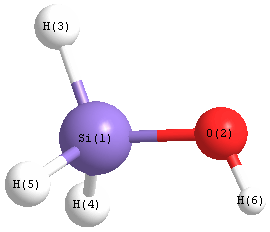Vibrational Frequencies calculated at B1B95/6-31G*
| Mode Number |
Symmetry |
Frequency
(cm-1) |
Scaled Frequency
(cm-1) |
IR Intensities
(km mol-1) |
Raman Act
(Å4/u) |
Dep P |
Dep U |
|---|
| 1 |
A' |
3878 |
3681 |
75.66 |
85.80 |
0.29 |
0.45 |
| 2 |
A' |
2311 |
2194 |
138.63 |
99.52 |
0.26 |
0.42 |
| 3 |
A' |
2255 |
2141 |
122.77 |
153.79 |
0.08 |
0.16 |
| 4 |
A' |
1022 |
970 |
219.41 |
15.86 |
0.68 |
0.81 |
| 5 |
A' |
972 |
923 |
112.84 |
17.98 |
0.75 |
0.86 |
| 6 |
A' |
915 |
869 |
58.21 |
13.89 |
0.74 |
0.85 |
| 7 |
A' |
859 |
815 |
162.25 |
7.78 |
0.21 |
0.34 |
| 8 |
A' |
689 |
654 |
71.94 |
6.07 |
0.68 |
0.81 |
| 9 |
A" |
2250 |
2136 |
234.44 |
64.11 |
0.75 |
0.86 |
| 10 |
A" |
942 |
894 |
86.91 |
22.32 |
0.75 |
0.86 |
| 11 |
A" |
726 |
689 |
82.12 |
11.39 |
0.75 |
0.86 |
| 12 |
A" |
229 |
217 |
121.18 |
2.39 |
0.75 |
0.86 |
Unscaled Zero Point Vibrational Energy (zpe) 8523.5 cm
-1
Scaled (by 0.9493) Zero Point Vibrational Energy (zpe) 8091.4 cm
-1
See section
III.C.1 List or set vibrational scaling factors
to change the scale factors used here.
See section
III.C.2
Calculate a vibrational scaling factor for a given set of molecules
to determine the least squares best scaling factor.
Charges, Dipole, Quadrupole and Polarizability
Charges from optimized geometry at B1B95/6-31G*
Charges (e)
| Number |
Element |
Mulliken |
CHELPG |
AIM |
ESP |
| 1 |
Si |
0.553 |
|
|
|
| 2 |
O |
-0.718 |
|
|
|
| 3 |
H |
-0.073 |
|
|
|
| 4 |
H |
-0.095 |
|
|
|
| 5 |
H |
-0.095 |
|
|
|
| 6 |
H |
0.429 |
|
|
|
Electric dipole moments
Electric dipole components in Debye
(What's a Debye? See section
VII.A.3)
| |
x |
y |
z |
Total |
| |
-1.497 |
0.016 |
0.000 |
1.497 |
| CHELPG |
|
|
|
|
| AIM |
|
|
|
|
| ESP |
|
|
|
|
Electric Quadrupole moment
Quadrupole components in D Å
| Primitive |
|---|
| | x | y | z |
|---|
| x |
-19.572 |
-3.102 |
0.000 |
| y |
-3.102 |
-20.042 |
0.000 |
| z |
0.000 |
0.000 |
-21.551 |
|
| Traceless |
|---|
| | x | y | z |
|---|
| x |
1.224 |
-3.102 |
0.000 |
| y |
-3.102 |
0.520 |
0.000 |
| z |
0.000 |
0.000 |
-1.743 |
|
| Polar |
|---|
| 3z2-r2 | -3.487 |
|---|
| x2-y2 | 0.469 |
|---|
| xy | -3.102 |
|---|
| xz | 0.000 |
|---|
| yz | 0.000 |
|---|
|
Polarizabilities
Components of the polarizability tensor.
Units are
Å
3 (Angstrom cubed)
Change units.
| |
x |
y |
z |
| x |
3.639 |
-0.119 |
0.000 |
| y |
-0.119 |
3.587 |
0.000 |
| z |
0.000 |
0.000 |
3.406 |
<r2> (average value of r
2) Å
2
| <r2> |
39.105 |
| (<r2>)1/2 |
6.253 |
